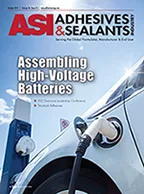Ask Dr. Dave
The two-component epoxy we're using in a metal assembly operation on small parts doesn't cure fast enough. Can you help?
Dave Dunn's May 2018 column.
Question: We are bonding steel to etched PTFE with an epoxy adhesive for outdoor applications. The bonds are quite strong, but appear to discolor and lose strength in the field. The PTFE side is exposed to sunlight. What do you think is the problem?
Answer: The probable reason for your problem is the ultraviolet (UV) transparency of the plastic and the fact that epoxy bonds are not very UV resistant. Even epoxy coatings are not recommended for outdoor applications because they discolor under UV. While PTFE is very resistant to degradation by UV light and may appear translucent, it does transmit UV light, which is almost certainly degrading your epoxy adhesive.
I have two suggestions. First, it may be possible to shield your bondline from the sunlight. Second, you might try acrylic adhesives, which are very resistant to UV.
Question: We use a high-performance two-component epoxy in a metal assembly operation on small parts, but it doesn’t cure fast enough so that we can handle the parts in a minute or two to increase productivity. What can you suggest to help us? (We cannot change the adhesive because it meets all specifications.)
Answer: In some operations, two-component epoxies can be fixtured very rapidly by exposing them to high heat or induction curing, followed by slower full curing at ambient temperature. Look at possible methods to apply heat to the bondline for a short period of time. If your part size and volume of parts allow it, a very simple technique is merely to place the parts under a heat lamp, in a heat tunnel or in an oven. A temperature of 130-150°F for a few minutes should be sufficient to fixture the parts. ASI
Any views or opinions expressed in this column are those of the author and do not represent those of ASI, its staff, Editorial Advisory Board or BNP Media.
Looking for a reprint of this article?
From high-res PDFs to custom plaques, order your copy today!




